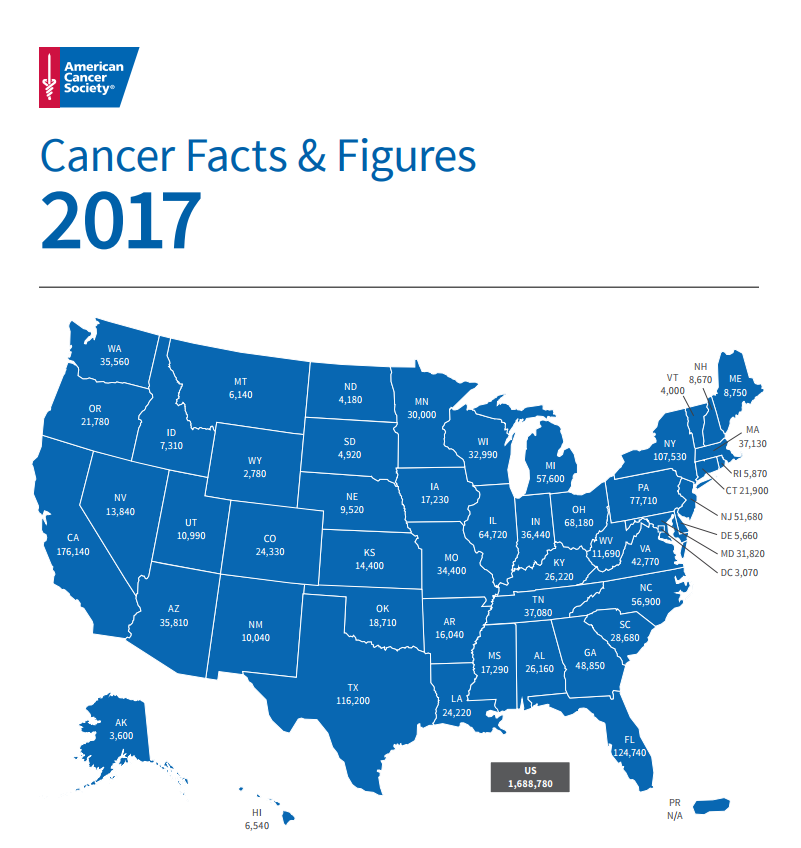Cancer Quick Facts
Cancer Answers
- The survival rate for many types of cancer has improved in recent years; however, cancer is still the second leading cause of death in the United States.
- Cancer occurs when cells continue to grow and divide and do not die when they should. Cancer cells can damage or destroy nearby tissues and can metastasize (spread) to distant parts of the body through the bloodstream or lymphatic system.
- Cancer is the result of changes in the genes that control normal cell growth and death. These changes may be inherited, or may result from environmental or lifestyle factors.
- People can reduce their risk of cancer by adopting a healthy lifestyle. Also, screening exams can detect some precancerous conditions and early-stage cancer.
- Cancer can cause a variety of symptoms.
- Cancer can be treated with surgery, radiation therapy, chemotherapy, hormones, and/or biological therapy.
- Clinical trials (research studies with people) are an option for people interested in prevention, screening, diagnosis, and treatment of cancer.
- About 1.4 million new cases of cancer will be diagnosed in the United States in 2005, and more than 550,000 people will die of the disease.
- Cancer is the second leading cause of death in the United States. However, improvements in cancer detection, diagnosis, and treatment have increased the survival rate for many types of cancer. About 64 percent of all people diagnosed with cancer will be alive 5 years after diagnosis.
![]()
Understanding Prognosis and Cancer Statistics
- A prognosis gives an idea of the likely course and outcome of a disease.
- Many factors affect a person’s prognosis, including the type, location, and stage of the disease, as well as the person’s age, general health, and response to treatment.
- Survival rates indicate the percentage of people with a certain type and stage of cancer who survive the disease for a specific period of time after their diagnosis. Survival rates are based on large groups of people.
- Doctors cannot be absolutely certain about the outcome for a particular patient. In fact, a person’s prognosis may change over time.
People facing cancer are naturally concerned about what the future holds. Understanding cancer and what to expect can help patients and their loved ones plan treatment, think about lifestyle changes, and make decisions about their quality of life and finances. Many people with cancer want to know their prognosis. They may ask their doctor or search for statistics on their own.
 A prognosis gives an idea of the likely course and outcome of a disease—that is, the chance that a patient will recover or have a recurrence (return of the cancer). Many factors affect a person’s prognosis. Some of the most important are the type and location of the cancer, the stage of the disease (the extent to which the cancer has metastasized, or spread), or its grade (how abnormal the cancer cells look and how quickly the cancer is likely to grow and spread).
A prognosis gives an idea of the likely course and outcome of a disease—that is, the chance that a patient will recover or have a recurrence (return of the cancer). Many factors affect a person’s prognosis. Some of the most important are the type and location of the cancer, the stage of the disease (the extent to which the cancer has metastasized, or spread), or its grade (how abnormal the cancer cells look and how quickly the cancer is likely to grow and spread).
Other factors that may also affect the prognosis include the person’s age, general health, and response to treatment. When doctors discuss a person’s prognosis, they carefully consider all factors that could affect that person’s disease and treatment, and then try to predict what might happen. The doctor bases the prognosis on information researchers have collected over many years about hundreds or even thousands of people with cancer. When possible, the doctor uses statistics based on groups of people whose situations are most similar to that of an individual patient.
The doctor may speak of a favorable prognosis if the cancer is likely to respond well to treatment. The prognosis may be unfavorable if the cancer is likely to be difficult to control. It is important to keep in mind, however, that a prognosis is only a prediction. The doctor cannot be absolutely certain about the outcome for a particular patient.
Survival rates indicate the percentage of people with a certain type and stage of cancer who survive the disease for a specific period of time after their diagnosis. Often, statistics refer to the 5-year survival rate, which means the percentage of people who are alive five years after diagnosis, whether they have few or no signs or symptoms of cancer, are free of disease, or are having treatment. Survival rates are based on large groups of people. They cannot be used to predict what will happen to a particular patient. No two patients are exactly alike, and treatment and responses to treatment vary greatly.
Cancer patients and their loved ones face many unknowns. Some people find it easier to cope when they know the statistics. Other people find statistical information confusing and frightening, and they think it is too impersonal to be of use to them. The doctor who is most familiar with a patient’s situation is in the best position to discuss the prognosis and to explain what the statistics may mean for that person. At the same time, it is important to understand that even the doctor cannot tell exactly what to expect. In fact, a person’s prognosis may change if the cancer progresses, or if treatment is successful.
Seeking information about the prognosis is a personal decision. It is up to each patient to decide how much information he or she wants and how to deal with it.
